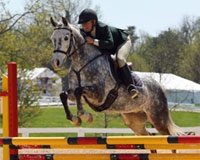- strengthening his hind end (especially helpful for horses coming off a layup);
- improving his rhythm;
- keeping boredom at bay.
Benefits for the rider include:
- developing your eye;
- improving timing;
- promoting proper balance (it goes without saying that you should never hang on your horse’s mouth to keep your balance over any ground pole exercise);
- focusing your attention on steering and straightness.
Ground poles are easy to set up (no lugging heavy standards around!) and there is no limit to the exercises you can create with them. You can even build challenges to longe your horse over!
Getting Started with Ground Poles
If your horse has never worked over ground poles before, start slowly, with one pole on the ground at a time, adding additional poles slowly. Once your horse has that down pat, you can add more poles and work on additional exercises. Give him time to look at each exercise and work on straightness and a steady tempo over whatever ground pole exercise you create.
No matter what gait you’re working in, your horse’s feet should land in the center of the space between the poles. If they don’t, you’ll need to adjust the spacing, either rolling the poles in or stretching the space out to make sure that it’s comfortable for him to get through the poles.
At any gait, the spacing will depend on the size of your horse’s stride. It may even vary depending on how he is at different points in the ride, like before he has truly warmed up and when he is working his entire body to get over the poles.
A good place to begin the distance between your poles for an average-size horse is:
- Walk poles: 2½’ to 3’ apart
- Trot poles: 4’ to 4 1/2’ apart
- Canter poles: 9’ to 10’ apart
Trot poles encourage your horse to stretch his stride length and drive with his hind end, while not placing stress on joints and tendons like jumping would. No matter what exercise you’re working on, or at what gait, be sure to sit tall and square in your saddle, and give him fair warning of what’s coming if you’re coming to an exercise out of a corner.
If you’re planning on posting, post through the exercises; if you’re working on canter work, stay in a light half seat. Don’t look down at the poles, either; this will put additional weight on your horse’s front end. Look up and across them. The goal is not to jump the poles, the goal is to keep him at the same pace so he learns where to place his feet and keep a consistent tempo.

Patterns Over Poles
Once your horse is working well over trot poles in a line, it’s time to mix things up. One of the easiest exercises to do is to place once pole in the middle of a figure-eight pattern, and work on keeping your horse straight before and after the pole. Additionally, you can place poles in the middle of a two- or three-loop serpentine to again work on staying straight and changing your horse’s bend over the pole.
But even that can get boring! Here are some other exercises you can try to keep your horse interested, get him in shape and work on straightness, tempo and adjustability without any added stress on his legs.
Exercise One: Raise It Up
If plain walk, trot and canter poles are getting boring, try elevating them. You can use jump standards for this or you can use specially made cavaletti. There are a few variations of this exercise as well; you can raise just one end, alternating ends of the poles, or you can raise both ends (creating a tiny vertical) to require your horse to lift and use himself more through the exercise.
Exercise Two: Four-pole Canter a Circle
While this exercise may not seem too tricky, it’s actually quite difficult to keep your horse on the same step and prevent him from bulging and disrupting his rhythm. To complete this exercise, place four poles down in the 12, 3, 6 and 9 o’clock positions of a 20-meter circle. Begin at the walk, making sure your horse is bent evenly from poll to tail and that he takes the same number of steps between each pole. Progress to the trot and then the canter, but be prepared—it really is harder than it sounds! Once you’ve gotten this down pat, try raising one side of the poles for added difficulty.
Exercise Three:
If you’re looking for an exercise that works even more on rideability and makes your horse think rather than go into autopilot, this should do the trick. Place four poles end-to-end in a zig zag pattern, making sure you have room to work off the rail. You will begin by trotting over the pole, then circling to change direction, over another rail, and circle in the opposite direction. At the end, you will have circled over each pole. Once you have the trot down, try it at the canter. Once your horse has the ability to do this exercise making larger circles, whittle down the size of the circles to 10 meters or less to truly work on his balance and get him thinking. Read more about this exercise at EventingConnect.today.
Sarah Coleman has a soft spot for chestnuts with chrome, including her off-the-track Thoroughbred that she competes in the hunters. Based in Lexington, Ky., she is the Director of Education and Development for New Vocations Racehorse Adoption Program.





